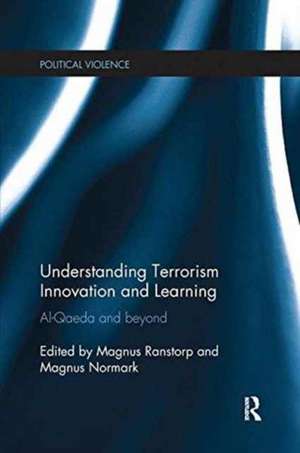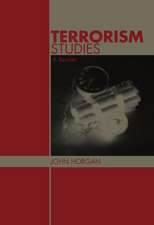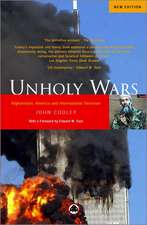Understanding Terrorism Innovation and Learning: Al-Qaeda and Beyond: Political Violence
Editat de Magnus Ranstorp, Magnus Normarken Limba Engleză Paperback – 30 noi 2016
It is often said that terrorist groups are relatively conservative in character operating in a technological vacuum – relying almost exclusively on bombs and bullets. This observation masks increasing complexity and creativity and innovation within terrorist groups and one of the most distinguishing features of al-Qaeda’s terrorist operations is its propensity for remarkable innovation. This book examines how and why terrorist groups innovate more generally and al-Qaeda-related terrorist plots in Europe more specifically. The starting point for this book was twofold. Firstly to examine the issue of innovation and learning more generically both in theory, within specific themes and within the context of al-Qaeda’s influence on this process. Secondly, this book examines the evolution of specific al-Qaeda-related plots in three specific northern EU states – the United Kingdom, Denmark and Germany - where there has been a significant volume of planned, failed and executed terrorist plots. In particular, these case studies explore signs of innovation and learning.
This book will be of much interest to students of terrorism and counter-terrorism, political violence, security studies and IR in general.
| Toate formatele și edițiile | Preț | Express |
|---|---|---|
| Paperback (1) | 369.73 lei 43-57 zile | |
| Taylor & Francis – 30 noi 2016 | 369.73 lei 43-57 zile | |
| Hardback (1) | 1058.65 lei 43-57 zile | |
| Taylor & Francis – 24 apr 2015 | 1058.65 lei 43-57 zile |
Din seria Political Violence
-
 Preț: 280.17 lei
Preț: 280.17 lei -
 Preț: 325.72 lei
Preț: 325.72 lei -
 Preț: 280.14 lei
Preț: 280.14 lei -
 Preț: 317.26 lei
Preț: 317.26 lei - 18%
 Preț: 1112.21 lei
Preț: 1112.21 lei -
 Preț: 470.07 lei
Preț: 470.07 lei -
 Preț: 391.34 lei
Preț: 391.34 lei - 25%
 Preț: 325.02 lei
Preț: 325.02 lei -
 Preț: 348.11 lei
Preț: 348.11 lei -
 Preț: 410.46 lei
Preț: 410.46 lei - 13%
 Preț: 296.19 lei
Preț: 296.19 lei -
 Preț: 408.00 lei
Preț: 408.00 lei - 18%
 Preț: 1112.90 lei
Preț: 1112.90 lei -
 Preț: 485.46 lei
Preț: 485.46 lei -
 Preț: 393.26 lei
Preț: 393.26 lei -
 Preț: 490.40 lei
Preț: 490.40 lei -
 Preț: 416.52 lei
Preț: 416.52 lei - 18%
 Preț: 1113.12 lei
Preț: 1113.12 lei -
 Preț: 494.07 lei
Preț: 494.07 lei - 8%
 Preț: 389.22 lei
Preț: 389.22 lei -
 Preț: 435.21 lei
Preț: 435.21 lei - 16%
 Preț: 306.13 lei
Preț: 306.13 lei -
 Preț: 442.83 lei
Preț: 442.83 lei - 18%
 Preț: 1444.61 lei
Preț: 1444.61 lei - 18%
 Preț: 1112.53 lei
Preț: 1112.53 lei -
 Preț: 391.50 lei
Preț: 391.50 lei - 18%
 Preț: 1278.08 lei
Preț: 1278.08 lei -
 Preț: 317.26 lei
Preț: 317.26 lei - 21%
 Preț: 243.29 lei
Preț: 243.29 lei - 18%
 Preț: 1113.16 lei
Preț: 1113.16 lei - 33%
 Preț: 326.14 lei
Preț: 326.14 lei -
 Preț: 447.17 lei
Preț: 447.17 lei -
 Preț: 209.56 lei
Preț: 209.56 lei - 30%
 Preț: 847.31 lei
Preț: 847.31 lei - 18%
 Preț: 1173.97 lei
Preț: 1173.97 lei
Preț: 369.73 lei
Nou
Puncte Express: 555
Preț estimativ în valută:
70.77€ • 76.90$ • 59.49£
70.77€ • 76.90$ • 59.49£
Carte tipărită la comandă
Livrare economică 21 aprilie-05 mai
Preluare comenzi: 021 569.72.76
Specificații
ISBN-13: 9780415787185
ISBN-10: 0415787181
Pagini: 298
Ilustrații: 2
Dimensiuni: 156 x 234 x 24 mm
Greutate: 0.45 kg
Ediția:1
Editura: Taylor & Francis
Colecția Routledge
Seria Political Violence
Locul publicării:Oxford, United Kingdom
ISBN-10: 0415787181
Pagini: 298
Ilustrații: 2
Dimensiuni: 156 x 234 x 24 mm
Greutate: 0.45 kg
Ediția:1
Editura: Taylor & Francis
Colecția Routledge
Seria Political Violence
Locul publicării:Oxford, United Kingdom
Public țintă
Postgraduate, Professional, and UndergraduateCuprins
1. Introduction, Magnus Ranstorp & Magnus Normark 2. The Theoretical Underpinnings of Terrorist Innovation Decisions, Gary Ackerman 3. Innovation and Improvised Explosive Devices, John Allison 4. The Dynamics of Terrorism Innovation, Adam Dolnik 5. Attacking the West: The Influence of Al-Qaeda’s Ideology and Propaganda, Søren Hove 6. Jihadist Innovation and Learning by Adapting to the `New´and `Social Media´ Zeitgeist, Nico Prucha 7. Learning Terror: The Evolving Threat of Overseas Training to the West, Paul Cruickshank 8. Innovation in Terrorist’s Counter-Surveillance: The Case of Al-Qaeda and Its Affiliates, Joshua Sinai 9. Innovation and Learning in British Jihad, Raffaello Pantucci 10. Terrorists Lack Imagination when Choosing Targets in Denmark, Morten Skjoldager 11. "Please Inform Europe": Al-Qaeda's Europlot of 2009/2010 in the Lights of New Documents and Testimonies, Yassin Musharbash and Guido Steinberg 12. Changing Patterns in Terror Plots directed against Germany emanating from militant Uzbek Networks in Waziristan, Yassin Musharbash and Guido Steinberg 13. Conclusions, Magnus Ranstorp and Magnus Normark
Notă biografică
Magnus Ranstorp is Research Director at the Center for Asymmetric Threat Studies (CATS) at the Swedish National Defence College, Stockholm, and author/editor of five previous books, including, most recently, Understanding Violent Radicalisation (Routledge, 2010).
Magnus Normark is a Senior Analyst at the Division of CBRN Defence and Security at the Swedish Defence Research Agency (FOI). He is the co-editor of Unconventional Weapons and International Terrorism (Routledge 2009).
Magnus Normark is a Senior Analyst at the Division of CBRN Defence and Security at the Swedish Defence Research Agency (FOI). He is the co-editor of Unconventional Weapons and International Terrorism (Routledge 2009).
Descriere
This book examines the role of terrorist innovation and learning in theory and practice, within the context of three specific EU case-studies.











